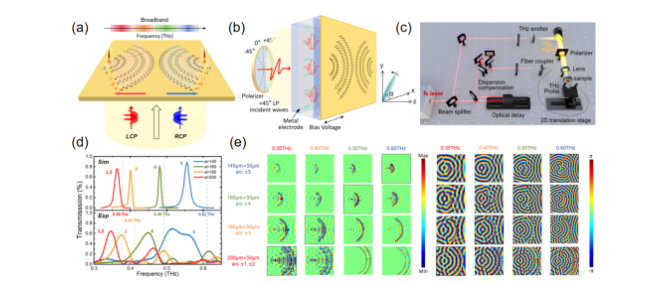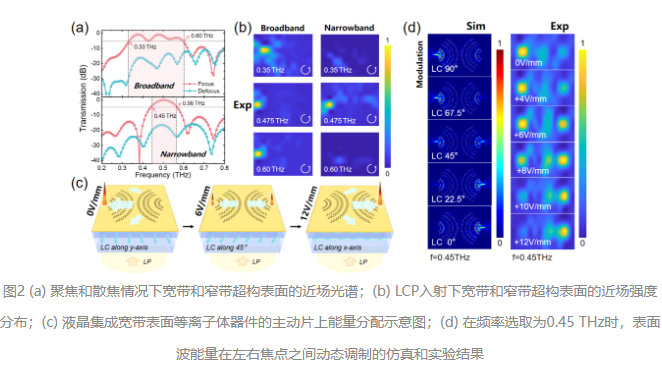23
2024
-
12
Using liquid crystal integrated metasurfaces to achieve actively tunable terahertz surface wave broadband on-chip focusing.
Author:
Terahertz functional devices have important application value in fields such as radar, high-resolution imaging, and biochemical sensing. In recent years, terahertz metasurfaces have made significant progress in the flexible manipulation of free-space beams. To further meet the demands for miniaturization, high efficiency, and low energy consumption in terahertz systems, exploring on-chip surface wave propagation control mechanisms is particularly important. Surface plasmon polaritons (SPPs) are conducive to constructing highly integrated ultra-compact devices, with limitless prospects in the field of on-chip photonics. However, in the terahertz band, SPPs are difficult to be highly localized on smooth metal surfaces, hindering the development of terahertz on-chip devices.
In the field of on-chip transmission of terahertz waves, structured metallic metasurfaces composed of sub-wavelength units have shown great potential. Currently, many research teams are dedicated to studying efficient generation and flexible wavefront control of surface waves; however, previous studies have mostly been limited to narrow-band frequency ranges. Additionally, due to difficulties in integrating functional materials on chips and their interaction with terahertz waves, existing devices often have fixed functions or can only switch passively. There are relatively few experimental reports on active terahertz surface plasmon devices, indicating a pressing need for developing broadband on-chip transmission and active control devices for terahertz.
Professors Fan Fei and Chang Shengjiang from Nankai University's School of Electronic Information and Optical Engineering developed a surface plasmon device based on an arc array slit metasurface integrated with liquid crystals that successfully achieved broadband focusing and active modulation of surface waves.This device utilizes a mirror-symmetric distribution of concentric arc slit resonator arrays to achieve selective directional focusing of surface waves based on different incident photon spin states; by precisely designing the geometric dimensions of the slits and their arc radii, it meets the phase matching conditions for broadband focusing at the focal point, thus achieving achromatic focusing. Furthermore, the introduction of liquid crystals provides an active polarization conversion method that can dynamically allocate surface wave focusing energy between left and right focal spots.The relevant research results were published under the title'Active Broadband Unidirectional Focusing of Terahertz Surface Plasmonics Based on Liquid Crystal Integrated On-Chip Metadevices''inPhotonics Research ,2024, No..

(a) Functional schematic diagram of broadband metasurface based on arc array slit resonators; (b) Working principle schematic diagram of liquid crystal integrated broadband surface plasmon device; (c) Near-field scanning terahertz time-domain spectroscopy system; (d) Transmission spectra of slit metasurfaces with different geometric sizes; (e) Near-field (real part) distribution and phase distribution maps corresponding to each arc resonator at different frequencies.
(a) The broadband metasurface based on arc array slit resonators is shown in Figure 1(a), where its mirror-symmetric structure allows surface waves to be selectively focused to one side based on incident spin states. As shown in Figures 1(d)-1(e), slits with different geometric sizes correspond to different excitation frequencies for surface waves. By further precisely designing the radius of arcs where different slits are located, the surface waves excited by each arc can meet phase matching conditions for coherent interference at the focal point, thereby broadening the working frequency range of the metasurface. More cleverly, in the liquid crystal integrated surface plasmon device shown in Figure 1(b), the liquid crystal layer acts as a quarter-wave plate that utilizes an electric field to drive LC molecules' rotation for active modulation of surface wave energy between left and right focal points.
The team conducted experiments using a near-field scanning terahertz time-domain spectroscopy system as shown in Figure 1(c). Figures 2(a)-2(b) demonstrate that the metasurface achieves spin-dependent unidirectional focusing with broadband performance. Figure 2(c) indicates that when no external electric field is applied, liquid crystal molecules will pre-orient along'y'-axis direction with most surface wave energy concentrated at the left focal point. As external electric field increases gradually, LC molecules rotate towardsx-y'x'-axis direction until when an external electric field reaches up to12 V/mm where LC molecules completely align along'y'-axis direction until when an external electric field reaches up to12 V/mm where LC molecules completely align along轴取向,使得表面波能量集中在右侧焦点。该过程的仿真和实验结果如图2(d)所示。

结果表明,该液晶集成宽带表面等离子体器件的工作带宽可达270 GHz,与常规的窄带器件相比,带宽拓宽了2.45倍。片上焦斑的横向分辨率为0.32λ0,水平偏移量仅有12%。此外,表面波聚焦能量的调制深度可达73%。这项工作在太赫兹集成光子通信、信息处理和高灵敏度传感领域的应用有重要意义。
“表面等离子体波的强色散阻碍了太赫兹波在宽带通信和光信息处理等领域的应用,因此,实现片上消色差波前调制非常有价值。”通讯作者范飞教授表示,“虽然主动式太赫兹表面等离子体器件的报道比较少,但在微结构中引入功能材料的策略已广泛应用于超构表面以主动操纵自由空间太赫兹波,这对主动式太赫兹片上器件的开发具有参考意义。尤其是在太赫兹波段具有宽带可调各向异性的液晶,可以通过热、光、电和磁等手段连续可逆地调节相移。因此,将液晶结构与太赫兹片上器件相结合,被认为是开发主动式太赫兹片上器件的一种极具前景的方法。“
In future work, the team will focus on researching the wavefront manipulation mechanisms of surface plasmon waves and the functional diversity, multi-channel capability, tunability, reconfigurability, and programmability of surface plasmon devices. This will lay the foundation for the application of integrated photonic devices in various fields such as signal processing, information caching, information transmission, and information security.
LATEST NEWS
2025-01-09
Design and Development of Full-Spectrum Photodetectors
In recent years, the booming optoelectronic industry has changed the world and extended into many aspects of life. Among them, photodetectors (PDs) with a wide response bandwidth from deep ultraviolet to visible to near-infrared serve as important optoelectronic components and play a key role in daily life.
2025-01-08
Black arsenene multi-spectral integrated field-effect transistors, aiding high-resolution imaging and enhanced secure communication.
With the development of modern communication technology, the demand for broadband, room-temperature infrared, and terahertz (THz) detectors has rapidly increased. These detectors play a crucial role in fields such as telecommunications, security inspection, non-destructive testing, and medical diagnostics. However, existing optical detectors face challenges such as high intrinsic dark current and the need for low-temperature cooling, which limit their efficiency in detecting low-energy photons. Particularly in the terahertz band, the photon energy is insufficient to excite electron transitions from the valence band maximum (VBM) to the conduction band minimum (CBM), making effective optoelectronic conversion difficult. Therefore, researchers have been seeking ultra-broadband detectors that can operate at room temperature and respond to wavelengths ranging from visible light to the terahertz band.
2024-12-30
Laser-based tiered neurons achieve high-speed reservoir computing.
Neuromorphic computing is a computational paradigm that simulates the functions and architecture of biological neurons. A single biological neuron is a powerful computational unit with information processing capabilities, information transmission abilities, and memory functions. Therefore, it is crucial to design a photonic neuromorphic processor that can truly emulate the powerful computational functions of biological neurons.
2025-01-01
Design and Development of Full-Spectrum Photodetectors
In recent years, the rapidly growing optoelectronic industry has changed the world and extended into many aspects of life. Among them, photodetectors (PDs) with a wide spectral response from deep ultraviolet to visible to near-infrared serve as important optoelectronic components and play a key role in daily life.
2024-12-31
High-sensitivity quantum dot photodetectors from deep ultraviolet to near-infrared
In recent years, the rapidly growing optoelectronic industry has changed the world and extended into many aspects of life. Among them, photodetectors (PD) with deep ultraviolet-visible-near infrared full spectrum detection response serve as important optoelectronic components, playing a key role in daily life.

